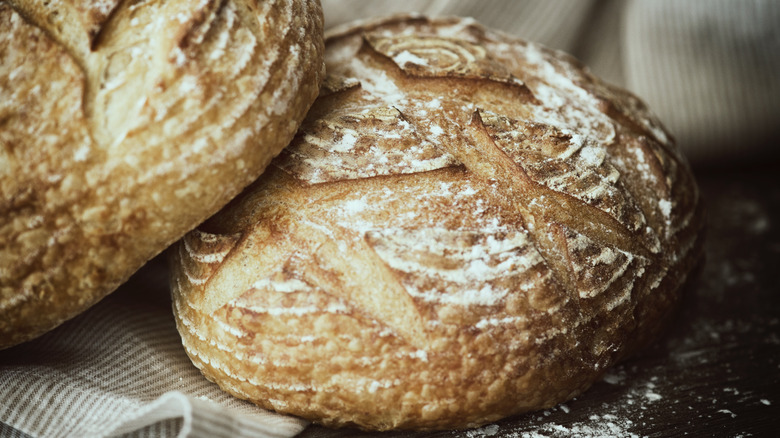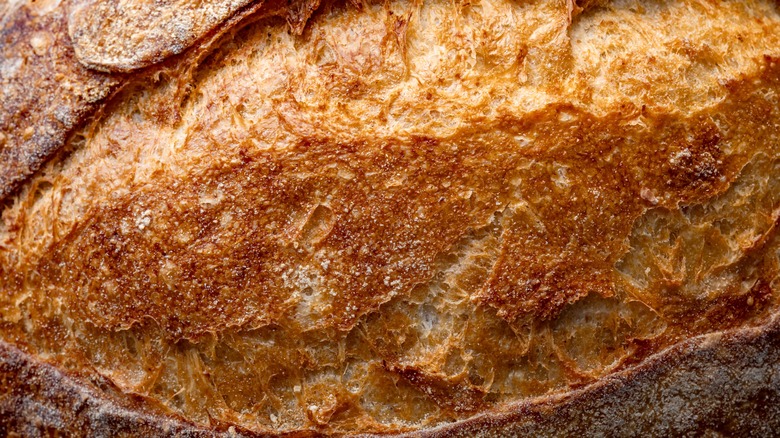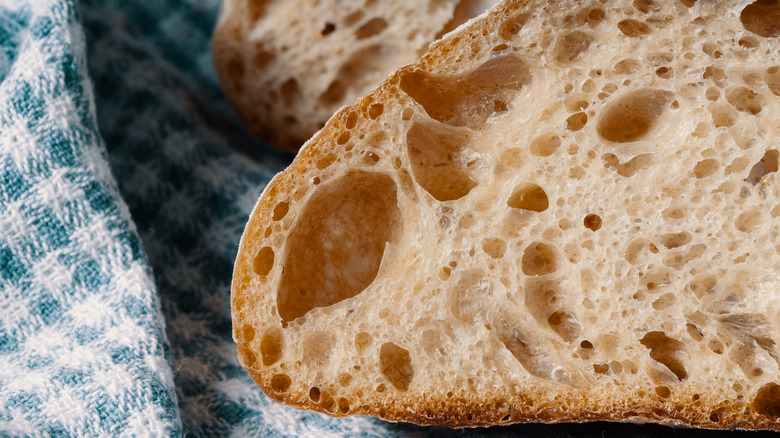The Ice Cube Hack That Makes Homemade Bread Crispier Than Ever
Every home cook should try baking bread at least once in their life. For starters, making your own bread can save you money; plus, it will make your kitchen smell like heaven all day. Those aren't even the best parts, however, because what really makes homemade bread stand out is its texture. The texture of bread is never better than in the first few hours after it's been baked (and rested), and the only way to guarantee you eat it in that window is to make it at home. The crumb will be at its most tender, but the biggest difference is really in the crust.
It's important to note here that not every kind of bread should be crusty — for example, a soft potato bun or Japanese milk bread. When you really want a crust is when you're working with sourdough. When a sourdough starter is ripe, it will fill your bread with tiny pockets of gas that translate to an airy crumb, and a crust speckled with golden brown bubbles. In order to get that crust, though, you'll need to turn to your freezer.
It might sound odd, but baking your bread in a Dutch oven with a couple of ice cubes will give you the crispiest crust. That's because you need steam in the oven to trigger crust development. It's the result of a neat bit of culinary chemistry that not only guarantees a crisp crust, but also gives you a better rise in every loaf.
How steam creates a better bread crust
What you'll need to pull off this trick, other than your loaf of bread, is a Dutch oven and a few ice cubes (use one to four cubes depending on size; more than that will create too much moisture). Add the bread and ice to the Dutch oven and put on the lid in order to trap the steam. Then, you're ready to bake. When that bread hits the heat, the ice will melt and evaporate, filling the Dutch oven with steam. That moisture will steadily collect on the surface of the bread, and when the dough reaches 180 degrees, magic starts to happen.
At 180 degrees, the starches on the surface of the dough begin to absorb all the moisture that's collected. Eventually, the scratches take in so much water that they explode, splattering a starchy gel all over the surface of the bread, which then crisps up in the heat. This is where those beautiful golden blisters on a perfect bread crust come from.
There's a reason that the crust of a loaf of bread darkens so much in the oven while the interior remains pale. It's a chemical process called the Maillard reaction, wherein the natural sugars in the dough react with amino acids under heat to cause browning. It's the same reason a pan-seared ribeye steak gets a crust. If the Maillard reaction is triggered too early, the bread crust will burn, but steam temporarily cools the baking environment, ensuring this doesn't happen.
How steam improves the interior of a loaf
Using ice cubes when you bake bread does more than develop a crispy, golden crust. It also improves the rise on your loaf, giving you an airier interior crumb and a more voluminous loaf. It's widely held that proofing is the hardest bread baking step, and the last thing you want is to ruin a good proof in the baking process. This can happen if your bread forms a crust too early in the baking process. If the surface of the loaf gets too hot too fast, it will start to form a hard shell, which prevents the interior of the loaf from expanding. As a result, your loaf will come out with an overly-thick crust and a very dense crumb. Once again, steam is the solution to the problem.
Adding ice cubes to the Dutch oven with your bread will start the baking stage at a low temperature. That way, the bread heats up slowly, giving the crumb plenty of time to expand before the crust hardens. By the time the ice has fully melted and evaporated, the loaf will have swelled to a nice, plump size, and you should find lots of expanded air bubbles inside keeping the crumb light and chewy, not dense and gummy. This trick can even help to save an over-proofed loaf. It still won't rise as much as a proper proof, but the added time for expansion goes a long way towards preventing a dense loaf.


